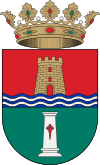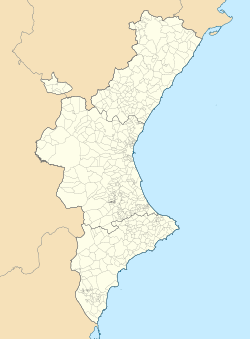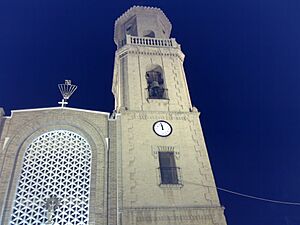Pilar de la Horadada facts for kids
Quick facts for kids
Pilar de la Horadada
|
|||
|---|---|---|---|
 |
|||
|
|||
| Motto(s):
Mar y Montaña
(Sea and Mountains) |
|||
| Country | |||
| Autonomous community | |||
| Province | Alicante | ||
| Comarca | Vega Baja del Segura | ||
| Judicial district | Orihuela | ||
| Area | |||
| • Total | 78.10 km2 (30.15 sq mi) | ||
| Elevation | 35 m (115 ft) | ||
| Population
(2018)
|
|||
| • Total | 21,418 | ||
| • Density | 274.238/km2 (710.27/sq mi) | ||
| Demonym(s) | Pilareño -a | ||
| Time zone | UTC+1 (CET) | ||
| • Summer (DST) | UTC+2 (CEST) | ||
| Postal code |
03190-03191-03192
|
||
| Official language(s) | Spanish | ||
Pilar de la Horadada (Spanish pronunciation: [piˈlaɾ ðe la oɾaˈðaða]) is a lovely town in the Province of Alicante, located in the southeast of Spain. It sits about 66 kilometers (41 miles) south of the city of Alicante. This makes it the southernmost town in the Valencian Community, very close to the border with the Province of Murcia.
The town and its nearby villages, like Pinar de Campoverde and Torre de la Horadada, are popular places for people from other countries to live. Many thousands of people from the UK, Germany, and other northern European countries call this area home. San Javier Airport in Murcia is also very close by, making it easy to travel to and from the area.
Contents
Nature and Wildlife in Pilar de la Horadada
This area is very special for its nature and wildlife. You can find many interesting plants here. These include hawthorn, globularia, mastic, Kermes Oak, and chamaerops (a type of palm).
The region is also home to many amazing birds of prey. Keep an eye out for peregrine falcons, golden eagles, European sparrowhawks, and kestrels flying high above!
Río Seco: A Unique Riverbed
The Río Seco, located in Pinar de Campoverde, is a river that usually doesn't have water for most of the year. Even without water, this area is very important. It provides a home for many local animals and plants.
Sierra Escalona: A Protected Zone
The Sierra Escalona is a special protected area. It helps to keep native animals safe, especially different kinds of birds. This protection helps these species to thrive in their natural environment.
Historical Sites and Fun Places to Visit
Pilar de la Horadada has many interesting places to explore, from old buildings to beautiful beaches.
Parish Church of Nuestra Señora del Pilar
In the center of town, you'll find the Parish Church of "Nuestra Señora del Pilar." The current church was built in 1986. It stands on the same spot where an older church once was. The bell tower from the original building is still standing today. The church is dedicated to the Blessed Virgin (Virgen del Pilar). Inside, you can see many beautiful religious artworks. These include pieces by local artists like José María Sánchez Lozano and Manuel Ribera Girona.
The Ancient Watch Tower
Near the beach in the village of Torre de la Horadada, there's an old Watch Tower. It was built in 1591. Its purpose was to protect the town's people from Mediterranean pirates. Imagine how important this tower was for safety hundreds of years ago!
Roman History: Thiar and the Quarry
The area has a rich Roman past. You can find archaeological ruins of an old Roman town called Thiar. This town was located on the Vía Augusta. This was a major Roman road connecting two very important Roman cities in Spain: Illici (Elche) and Carthago Nova (Cartagena).
You can also see the remains of a Roman quarry on the Mil Palmeras beach. This is where the Romans would have cut stones for their buildings.
Archaeological – Ethnological Museum
To learn more about the history of Pilar de la Horadada, visit the Archaeological – Ethnological Museum. It displays items from the past and shows how people used to live in the area.
Beautiful Beaches of Pilar de la Horadada
Pilar de la Horadada is famous for its stunning beaches. They stretch for five kilometers (about 3 miles) along the coast. These beaches have soft, white sand and are generally safe for swimming when the weather is calm.
Under the sea, you can discover amazing marine life and seagrass meadows called poseidonia. The high quality of these beaches is recognized by their "Blue Flag" awards. Las Higuericas and Mil Palmeras are two of the most popular beaches in the district.
Fun Festivals and Celebrations
The town loves to celebrate! Here are some of the main festivals:
- Festivals in honor of the Blessed Virgin: These celebrations take place from September 29th until October 30th. A special event is the Floral Tribute on October 11th. The main day is October 12th, with a Solemn Mass and a procession. One week later, "Las carrozas" (parades with decorated floats) are a big highlight.
- Summer Festivals: On July 30th, the town celebrates its independence from the Orihuela Council. This happened in 1986 and is a day of great pride and fun.
A Glimpse into History
Pilar de la Horadada has a long and interesting history. Because of its location, it was often a border town between two powerful kingdoms: the Kingdom of Murcia (from Castilla) and the Kingdom of Valencia. This meant it was sometimes the site of battles.
For many centuries, Pilar de la Horadada was a small farming town. It was known as Campo de la Horadada and had only a few houses. A big change happened in 1986 when it became independent from the Orihuela municipal district. This led to a boom in tourism.
Today, local fields are still used for growing vegetables by farming cooperatives like 'Surinver' and 'Teresa Hermanos'. Pilar de la Horadada enjoys a lovely Mediterranean climate, with the sea on one side and mountains on the other.
Sports in Town
If you're a football fan, you might be interested to know that Unión Deportiva Horadada is the local football club in Pilar de la Horadada.
See also
 In Spanish: Pilar de la Horadada para niños
In Spanish: Pilar de la Horadada para niños









